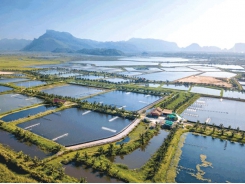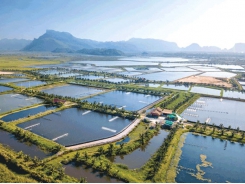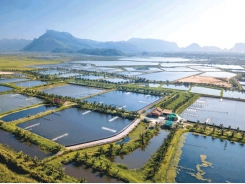Land Based Sustainable Aquaculture Strategy - Part 6

8/ Water licensing
A water licence or activity approval is required to install a pump, construct a levee, divert the river flow, undertake works within 40 metres of a river, install a bore or piezometer or to harvest more than 10% of catchment overland flows across a site.
Measuring water extraction
Under the water licence provisions for water extraction, NOW may, as conditions of licences or approvals, require the quantity of water to be recorded and reported, annually or more regularly, if required using approved measuring equipment. Information required will include hours pumped, monthly extraction rate and use of water. NOW may limit the extraction from a river from time to time to ensure adequate flows remain for other water users and the environment.
Estuarine or marine water supply
Tidal exchange
Ideally you need a satisfactory estuarine water supply on a site adjacent to waterways. The estuarine aquaculture maps (see Appendix 1) identify sites that potentially have water quality satisfactory for an estuarine water supply source.
Detailed investigations will be required to determine if there is good tidal exchange and circulation, and if the water quality is able to consistently recover quickly following rain events.
Avoid sites with significant freshwater ingress and variable salinity, high suspended solids, low pH (acid sulfate), high organic loading and other poor water quality characteristics.
Tidal amplitude
PREFERRED LOCATION
A site adjoining an estuary with a tidal amplitude of greater than 600 millimetres.
Ideally you need water intake sites in an area of good water ventilation. An indirect measure of ventilation is tidal amplitude. Tidal amplitude is defined as:
MHWN - MLWN where MWHN = Mean High Water Neap, and MLWN = Mean Low Water Neap.
Generally, tidal amplitude will diminish further up river systems and where restriction to tidal movement occurs such as narrow and/or shallow channels and sand bars. Tidal gauge data is available from the Manly Hydraulic Laboratories in Sydney. You may need the assistance of a coastal engineer to calculate tidal amplitude where there are no tidal gauges.
Avoid areas that may be adversely and significantly impacted by adjoining floodgates and land runoff.
Access
PREFERRED LOCATION
A site where no deepening is required of the estuary for a pumping station, or existing infrastructure exists to carry inlet and outlet pipes for estuarine or marine waters.
Carefully consider if potential inlet sites will require a change to the estuary channel (eg. require a sump or deepening or other disturbance of the bed of the estuary). If mangroves, seagrass or foreshore vegetation is likely to be disturbed, a permit may also be required under the Fisheries Management Act 1994.
Where it is proposed to undertake work (excavation, fillor anything that could affect the flow or quantity of water) in, on or within 40 metres of an estuary, a controlled activity approval will be required pursuant to the Water Management Act 2000.
Establishment of pipelines across ocean beaches to access marine waters requires detailed investigations as storms may result in catastrophic failure of the pipeline. You will need to consult with LPMA to obtain approval for the pipeline.
Note also that pipelines that cross SEPP 14 wetlands will trigger the requirement for an environmental impact statement and if a RAMSAR wetland is involved, a Commonwealth approval under the Environmental Protection and Biodiversity Conservation Act may be required.
Saline ground water supply
PREFERRED LOCATION
Adjacent to a saline ground water interception scheme.
Access to saline ground water may be from either a saline ground water interception scheme or bore. Care needs to be undertaken in managing the saline ground water within the aquaculture facility to ensure that freshwater aquifers are not impacted. You will need to consult with NOW.
All saline ground water bores must be of an approved diameter, lined and capped to the standards required and licensed by NOW.
Freshwater supply
Access licence or extraction rights
PREFERRED LOCATION
A site with an approved access licence or available rights for water extraction.
Water for freshwater fish farms can be drawn from sources such as streams, on-site dams, underground bore water or town supply providing the relevant permit/entitlement can be obtained. For advice on water extraction rights consult the NOW.
Water Access restrictions
PREFERRED LOCATION
A site with no water access restrictions based on flows under normal conditions.
Detailed investigations will be required to evaluate the reliability of water quantity and quality during drought periods, periods of high demand (multi-users), floods and ‘fresh’ river flows. Sites having the potential to experience periods of restricted water access should consider on-site storage or alternative sources (bores/wells) and have the capacity to support continued operation during these events.
Pumping station
PREFERRED LOCATION
A site requiring no deepening of the river for intake line and for easy management during floods.
Ideally you need a river site having sufficient depth under all flows and readily accessible to remove infrastructure for maintenance and during rising waters and floods. The existing profile of the channel or bank must not be disturbed more than is necessary to install the pumping facility.The intake should be as protected as possible from debris and excessive flows.
Any location where the bank or the bed of the river would require substantial disturbance (especially of aquatic or foreshore vegetation) should be avoided. The construction of a pump station may require a controlled activities approval under the Water Management Act 2000. Where a licence or permit issued for the commercial use of water, an exemption from controlled activity approvals exist, refer to clause 39A of the Water Management (General) Regulation 2004.
Related news
Tools

Phối trộn thức ăn chăn nuôi

Pha dung dịch thủy canh

Định mức cho tôm ăn

Phối trộn phân bón NPK

Xác định tỷ lệ tôm sống

Chuyển đổi đơn vị phân bón

Xác định công suất sục khí

Chuyển đổi đơn vị tôm

Tính diện tích nhà kính

Tính thể tích ao




 Land Based Sustainable Aquaculture Strategy - Part 7
Land Based Sustainable Aquaculture Strategy - Part 7  Land Based Sustainable Aquaculture Strategy - Part 5
Land Based Sustainable Aquaculture Strategy - Part 5